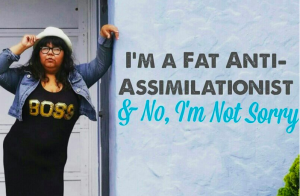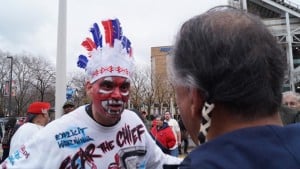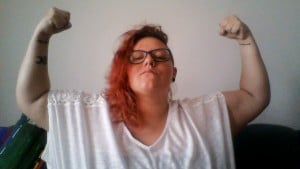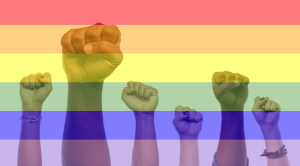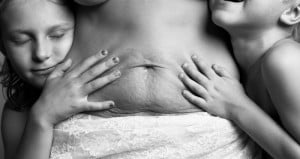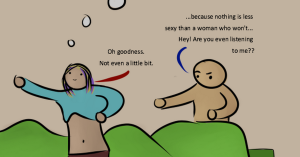Originally published on The Body Is Not an Apology and republished here with permission.
Last month I was in a public space. Meaning, I was in a space that left my body vulnerable to the interpretations of those around me and their responses.
Two strangers met nearby, and one asked the other a question that necessitated acknowledging me. The first did so, referring to me as “she” by saying “She’s waiting in line.” I noted this internally, bemused.
He then immediately stammered and – what he thought – corrected himself to gender me as “he.” I wanted to tell him it’s okay, he didn’t do anything wrong, that both and neither are right. Instead, I waited for my pizza to be ready, picked it up, and left.
This wasn’t the first time a stranger in a public space directly or indirectly expressed confusion about my gender. It won’t be the last.
Last week I was walking to my bus stop when I passed a stranger who was talking to several people on the street as they walked by. He said hi, so I responded in turn.
This led him to walk up to me, put his arm around me, and ask if I was gonna let him fuck me. I shrunk away, said no, and he took his arm away and went back to talking to other people on the street.
This isn’t the first time a man on the street has sexually harassed me in ways that mimic the street harassment so many women face daily. It won’t be the last.
One difference, I’m sure, wasn’t only my comfort in telling him no, but also him hearing my no and responding accordingly, though this hasn’t always been the case when I tell men no.
Still, the interaction was interesting to me in the way this person clearly interpreted my body in a way that was, if not woman, feminine-adjacent. He clearly read me as woman, or femme, or gay, or queer, or bottom – some experiences I identify with, and some I don’t.
I wondered, would he have approached someone in the same way who was taller? Hairier? Less fat? Fat in a different way? Darker? Would he have asked to be fucked rather than to fuck? Would he have needed to interpret someone as not straight to do so? And what identifiers is he looking for to do so?
As a person who was assigned male at birth, my fatness produces my gender in a very specific way.
I have a big, soft belly and what might be called breasts on a different body. This is a feminized fatness that is different from the hard, muscular guts found on athletes, and those in masculinized spaces like the bear community.
I have very little body hair that follows the patterns of my father and other Indigenous men I see who look like him. This is another marker of masculinity that my body fails, that, along with my fatness, locates me in a kind of gender purgatory – both, neither, all, and none.
The way I experience my gender getting produced the most – the way it feels most present and prominent – is through sexual currency.
In these moments and spaces, it becomes obvious most people who consider themselves men who are attracted to men have ideas of manhood that aren’t just cis, but non-disabled and thin or muscular as well.
For me, this begs the question: What makes a man? Particularly when thinking about the ways that normative queer spaces construct gender, manhood, and masculinity.
And, especially, when those men who are attracted to me seem to be already especially attracted to a specific type of fat body that aligns with mine. These bodies are called man or male.
But the physicality of our interactions, the language they use to refer to my body, the assumptions they make about my sexual positions and habits and, especially, how they position themselves and their own gender in relation to my body and my gender suggest that a multiplicity of genders are actually present in these interactions.
And this is particularly interesting because we might both use the shorthand of “man” to refer to ourselves.
Sometimes these interactions vary depending on how I’m dressed – whether I’m wearing big hoops or more subtle studs, make-up, or nail polish, or even a skirt, or a dress, but many times not.
Sometimes when I’m not wearing obviously coded feminine attire, my partners request it. The way this becomes an access point to desire for me is not lost on me.
In addition, I think back to my experiences of street harassment by men who presumably consider themselves straight – and how they approach me in a way that feels as if they experience me as adjacent to womanhood.
And the collection of straight-identified men who specifically like to sleep with fat men, implicitly differentiate this as a specific gender population – similar to the way men who identify as attracted to men imply the specific population of cis, thin/muscular, not-disabled, often white, and so on.
And, then, what are those who fall outside of or fail these standards?
There are many activists today doing amazing work around breaking down gender and challenging the binary. This is amazing and necessary work.
But what gets left out of the conversation are all the subtle intracacies of a body beyond genitals and the secondary sex characteristics that gender rely on, like race, ability, body size, and even shape.
Similar to the way my fatness interacts with my gender to position me outside of manhood, many fat women activists have pointed out how the fat positive movement and especially fatshion movements are dominated by pear-shaped smaller fat women.
This highlights how womanhood, as well, relies on specific body shapes and proportions to remain legible. What about the women who are apple-shaped, or merely round without the normal, appropriate or acceptable “curves?”
Disabled, queer activists have already talked about the way that normative gender performances rely on a non-disabled body. That the gestures and posturing necessary to render a gender legible on a body rely on movements not available to everyone.
I think this analysis needs to extend to fatness, as well.
What of people whose fatness produces a body where otherwise presumably obvious secondary sex characteristics become more ambiguous? Whose bodies challenge a presumably clear and defined binary of dichotomous and easily definable bodies?
Further, Black queer gender non-conforming activists and scholars, most notably Saidiya Hartman, have theorized how gender is always already racialized.
Under colonialism, racialized and colonized people – and Black folks especially – are set against a white gender standard that we’ll always fail. We’re always set against white masculinity and white femininity, which are always cis, muscular or thin, and not disabled.
The more I’ve experienced this the more that, in some ways, I feel like my fatness arrests my gender.
Regardless of how I feel and how I view my gender, there are material limits to what gender my body is allowed or – more appropriately – disallowed to access.
While I don’t have a desire to participate in it, I feel like my fatness has excommunicated me from masculinity and perhaps gender as a whole. This complicates the journey for me, as someone whose gender feels – at different times – coerced, contextual, erased, invisible, absent, aspirational, and failing.
The limits fatness places on my gender possibilities can be overwhelming. And I must acknowledge the other fat trans and gender non-conforming people who have very different relationships to their fatness and their gender – whose fatness may help, hinder, or place no bearing on their gender.
I don’t want my experience to minimize, undermine, or diminish theirs.
But as for me, I have come to a place of gender apathy.
Where gender becomes an experience much larger than me that I have little to no control over, and have forsaken any attempts. I feel no pressure to “figure” my gender out.
I’ve rejected any responsibility to reach a destination or to decipher what gender means for me and what role it occupies in my life and experiences. I’m not interested in presenting a road map or answers to a system that refuses to acknowledge the complexity of what informs all of our genders.
The closest I can come to articulating my gender is fat, and even this feels like offering more than what is deserved, like retrofitting a body to a system that never wanted it.
The feeling is mutual.
[do_widget id=’text-101′]
Caleb Luna is a Contributing Writer for Everyday Feminism. They are working-class, fat, brown queer living, writing, performing, and dancing in Oakland, California. They are a first-year PhD student at University of California, Berkeley, and their work explores the intersections of fatness, desire, fetishism, white supremacy, and colonialism from a queer of color lens. You can find more of their writing on Black Girl Dangerous and on Facebook and Tumblr. Read their articles here.
Search our 3000+ articles!
Read our articles about:
Our online racial justice training
Used by hundreds of universities, non-profits, and businesses.
Click to learn more












